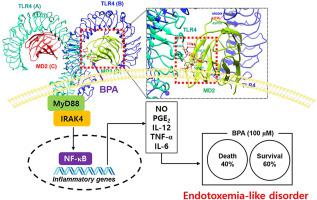Environmental Pollution ( IF 8.9 ) Pub Date : 2021-03-01 , DOI: 10.1016/j.envpol.2021.116829 Wisurumuni Arachchilage Hasitha Maduranga Karunarathne , Ilandarage Menu Neelaka Molagoda , Yung Hyun Choi , Sang Rul Park , Seungheon Lee , Gi-Young Kim

|
In addition to endocrine disruption, bisphenol A (BPA) is known to induce inflammation through the activation of nuclear factor-κB (NF-κB). However, detailed studies on the mechanism of NF-κB activation by BPA have not been sufficiently conducted. In the present study, we observed that low concentrations of BPA (≤1 μM) upregulated the release of proinflammatory mediators, including nitric oxide (NO) and prostaglandin E2 (PGE2), as well as proinflammatory cytokines, including tumor necrosis factor (TNF)-α, interleukin (IL)-12, and IL-6. Molecular modeling predicted that BPA docked with the Toll-like receptor 4 (TLR4)/myeloid differentiation factor 2 (MD2) complex activates downstream molecules including myeloid differentiation primary response 88 (MyD88) and IL-1 receptor-associated kinase 4 (IRAK-4) and results in the upregulation of the NF-κB signaling pathway. Additionally, BPA increased morphological abnormalities and mortality in zebrafish larvae and enhanced the dispersal of macrophages and neutrophils in the whole body, thereby causing an endotoxemia-like disorder. However, a specific TLR4 inhibitor, TLR4-IN-C34, mitigated BPA-induced mortality and morphological abnormalities, which indicates that the TLR4/MD2 complex is a molecular target of BPA-induced immunotoxicity. Collectively, our results indicate that low concentrations of BPA, which is a potential agonist of the TLR4/MD2 complex, can intensify the immune response and eventually cause an endotoxemia-like disorder.
中文翻译:

双酚A:潜在的Toll样受体4 /髓样分化因子2复合激动剂
除了内分泌干扰外,双酚A(BPA)还通过激活核因子-κB(NF-κB)诱导炎症。然而,关于双酚A激活NF-κB的机制的详细研究尚未充分进行。在本研究中,我们观察到低浓度的BPA(≤1μM)上调促炎性介质的释放,包括一氧化氮(NO)和前列腺素E 2(PGE 2)以及促炎性细胞因子,包括肿瘤坏死因子(TNF)-α,白介素(IL)-12和IL-6。分子建模预测,与Toll样受体4(TLR4)/髓样分化因子2(MD2)复合物对接的BPA激活下游分子,包括髓样分化主要反应88(MyD88)和与IL-1受体相关的激酶4(IRAK-4) )并导致NF-κB信号通路的上调。另外,BPA增加了斑马鱼幼虫的形态异常和死亡率,并增强了巨噬细胞和嗜中性粒细胞在全身的扩散,从而引起内毒素血症样疾病。但是,一种特定的TLR4抑制剂TLR4-IN-C34可以减轻BPA引起的死亡率和形态异常,这表明TLR4 / MD2复合物是BPA诱导的免疫毒性的分子靶标。总体而言,我们的结果表明,低浓度的BPA是TLR4 / MD2复合物的潜在激动剂,可增强免疫反应并最终导致内毒素血症样疾病。



























 京公网安备 11010802027423号
京公网安备 11010802027423号